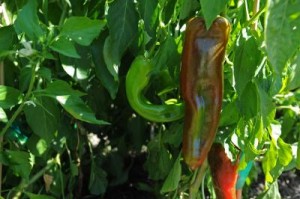
You can get a lot of chile from three-quarters of a million seeds. That’s how many chile seeds New Mexico State University’s Chile Pepper Institute has developed, grown and sold to backyard gardeners around the world since its inception. Plus, that doesn’t even include the amount of seeds the institute has bred specifically for the chile industry.
The chile pepper breeding program at NMSU began in the late 1800s with famed agriculturalist Fabian Garcia. Today, it specifically works with New Mexico chile growers to help them produce what they need for the state. The program also makes seed available for home gardeners, too, especially rare seeds not carried by the big seed companies.
“We really do get requests for seed from all over the world,” said Danise Coon, an agriculture research scientist at the Chile Pepper Institute. “We’ve heard from people anywhere from Okinawa, Japan, to Hamburg, Germany.
The Chile Pepper Institute was founded 21 years ago. Since that time, Coon estimates they have sold around 50,000 chile seed packets, including rare varieties and ones developed by NMSU. With 15 seeds per packet, that adds up to 750,000 seeds, and untold numbers of jalapenos, Bhut Jolokias and New Mexico green chiles.
The institute’s director, Paul Bosland, said whether it is an existing variety, or a new one they are trying to develop, a lot of research and scientific procedures are needed to develop the seeds and get them to growers.
“We listen to the growers and they make suggestions as to traits they would like to see in their chiles,” Bosland said. “One thing that people don’t realize is that chile peppers cross-pollinate. Insects will come, grab pollen from one plant and take it to the next. So we can get some mixture in the seed. We don’t want that; we want the variety to stay pure.”
He said once chile plants begin growing in the field, cloth screens are placed over the plants to keep the insects from pollinating them. Once the fruit sets and matures, it is harvested and the seeds are extracted.
“Extracting the seed can be a process unto itself,” he said. “If we have a mild chile, we just do it in the lab. But for the super-hots, like Trinidad Moruga Scorpion or Bhut Jolokia, we have to put on protective suits, masks and goggles to extract the seeds from the pods. The pungency of those chiles just overwhelms the laboratory.”
One variety that will be available next year from the Chile Pepper Institute is NuMex Sandia Select. It was originally grown as a red chile, which typically has a thin wall. To make it work as a green chile, researchers selected plants for a thicker fruit wall. Then they began replicating trials to ensure the chiles were statistically better.
“Sometimes there is a hybridization process,” Bosland said. “There, we use pollen from two different parents to develop offspring with new traits. The fastest time to finish from the first hybridization to releasing it to the public is five years; normally it takes a decade. It’s a very long process. We’re making hybridizations today that farmers won’t see for a decade.”
The institute will ship seeds to anywhere in the country and proceeds from seed sales fund future chile pepper research. The institute now sells 50 different varieties of rare and unusual seeds, not to mention the NuMex varieties, which were developed at NMSU.